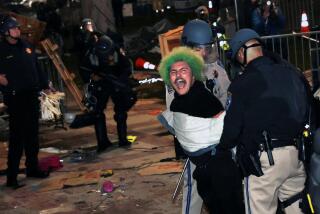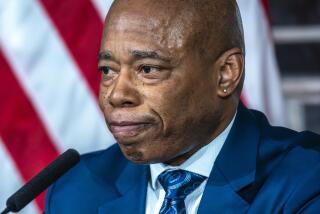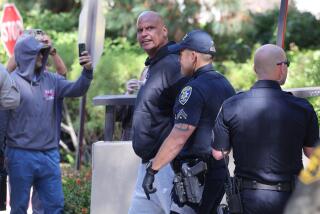Protesters Upset That Police Didn’t Tape Arrests : Rally: Peace activists claim it was no accident that the one encounter that turned violent didn’t get recorded.
- Share via
At each San Diego war protest this year, local police either videotaped the proceedings or kept cameras at hand in case violence occurred, and they needed footage to uphold arrest charges.
But when violence did erupt at a March 3 rally, in which three people were arrested and several were injured by police swinging nightsticks, no videotape was made. Protesters said it was no accident, suggesting that police wanted no record of the brutality.
In the past month, the protesters have formed a group called People Against Police Brutality, which has accused police of attacking the crowd without provocation.
On Tuesday night, 2 dozen attended a meeting of the Citizens Review Board on Police Practices and denounced the events of March 3--the same day that Los Angeles police officers were videotaped whipping Rodney G. King with nightsticks.
Police say that they did not film the protest because the war had ended and they did not anticipate another rally. Protesters provoked the violence, they said, when a member of the group hit a police officer with his cane and another struck a horse. Both were arrested.
A third protester, Guillermo Mendez, was arrested on suspicion of inciting a riot after he told the crowd to stop the police from making arrests, according to Capt. Kraig Kessler of the department’s special-enforcement division.
Kessler said the department was caught off-guard by the protest and had to call in units from other areas of the city.
“I wanted a video camera but didn’t have one,” Kessler said. “We had nothing to hide that day. I wish I had a videotape of what happened.”
So do the protesters.
“It’s ironic that (protesters) had been complaining about the videotaping, and the ACLU got into the act and Police Department stopped taking video cameras to the park two weeks before this happened,” said Bruce Root, a co-chairman of People Against Police Brutality who was at the protest that day.
“All the evidence suggests to us they were planning this arrest,” he said. “I wouldn’t think they’d want to be videotaping if they knew they’d be beating people up.”
Root and others tell a different story than police about the protest. That day, they said, they planned to march from Balboa Park to Horton Plaza and back again. During the march, which included a drum corps, the crowd of about 100 split into two groups and headed downtown.
On the way back, police on horseback kept protesters out of the street and on the sidewalk. Once back in the park, police officers drew their night sticks, Root said, and, when the group crossed a parking lot, police charged into the crowd.
Mendez, 25, arrested for inciting a riot and resisting arrest, said he used a megaphone to urge police not to arrest the protesters while comparing them unfavorably to the U.S. military. He said police rushed through the crowd, threw him to the ground, twisted his arm, and hit him with a night stick.
Another man arrested for allegedly striking an officer with a stick is a 49-year-old epileptic who uses a cane and was jailed for several days without receiving medical attention, Mendez said. A nearly blind woman was trampled by a horse and suffered back and neck injuries, he said.
Mendez said the charges against him and the man and woman have been reduced to misdemeanors.
After his arrest, Mendez said he was told by police that he had been videotaped at previous protests for “intelligence purposes. They told me they were gathering information on people for their data banks. I’ve been photographed, videotaped and harassed at all these demonstrations.”
Police say they do not film or photograph as part of an effort to keep files on anyone, and, if violence does not break out, they re-record over the tape.
Kessler said police stopped taping after the first few protests, and, in later demonstrations, merely kept cameras on hand in case they needed them. He said police did not tape at most of the demonstrations.
In fact, when protesters met with representatives of the Police Department to urge them to curtail filming at rallies, the police agreed to refrain from taping, said Deputy Chief Manny Guaderrama.
“We told our guys to cool it on the videotaping,” Guaderrama said. “They criticize us when we tape, and they criticize us when we don’t tape.”
More to Read
Sign up for Essential California
The most important California stories and recommendations in your inbox every morning.
You may occasionally receive promotional content from the Los Angeles Times.










